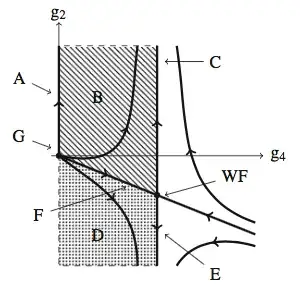The picture represents the Wilsonian RG acting on the space of all theories with unit UV cut-off (e.g. all theories you can put on the unit lattice). Of course there are a lot more axes which are not represented here. This is an infinite-dimensional dynamical system but the important slice for the matter at hand is the one regarding the $\phi^2$ or $g_2$ and the $\phi^4$ or $g_4$ directions. However a perhaps better coordinate system is that of Wick powers
$$
:\phi^2:=\phi^2-C_{1,\infty}(0,0)\ ,
$$
$$
:\phi^4:=\phi^4-6\ C_{1,\infty}(0,0)\ \phi^2+3\ C_{1,\infty}(0,0)^2
$$
where $C_{1,\infty}$ ist the free covariance with unit cutoff in the notations of
https://mathoverflow.net/questions/62770/what-mathematical-treatment-is-there-on-the-renormalization-group-flow-in-a-spac/63089#63089
This is because the Wick powers are the eigenvectors of the differential of the RG map at the origin, i.e., the Gaussian fixed point. By basic bifurcation theory, when you turn on a small $\epsilon>0$ a new fixed point (Wilson-Fisher) emerges from the origin in the direction of the eigenvector $:\phi^4:$. It's an example of transcritical bifurcation. So the line F is tangent at the origin to the $:\phi^4:$ axis. If you do the triangular change of coordinates between the Wick and non-Wick powers then you see that near the origin the equation of F is roughly
$$
g_2=-6\ C_{1,\infty}(0,0)\ g_4
$$
BTW I did not include factorials in my convention for $V$.
The picture correctly has a negative slope for the F line.
Edit as per Nikita's question below:
There are two different notions of mass here. There is the mass sitting in the Lagrangian (MSITL), i.e., $g_2$ or the coefficient of $\phi^2$. There is also the true mass (TM), i.e., $m$ defined by the decay of the two-point function.
Note that an another name I could have used for $g_2$ is the bare mass, but this would have created confusion because the bare mass is usually for a non unit cutoff and is dimensionful, whereas $g_2$ is dimensionless and belongs to a theory living (throughout the Wilsonian RG flow) on the unit lattice. Roughly $m$ is defined by the property that the two-point function behaves like $\langle\phi(x)\phi(y)\rangle\sim e^{-m|x-y|}$ for $x,y$ far apart on the unit lattice.
It is only in the trivial/uninteresting Gaussian case that $m=g_2$. In general $m=m(g_2,g_4,\ldots)$ is a very complicated nonlinear function of the couplings present in the Lagrangian. The theory is massless when $m=0$, so there is no reason for this to translate into $g_2=0$. In fact one needs $g_2<0$. A heuristic for this is that if one overshoots slightly towards more negative values of $g_2$ then one gets into the broken $\mathbb{Z}_2$ symmetry regime. Clearly this requires a double well potential trying to pretend to be the potential for an Ising model. If $g_2\ge 0$ (as well as $g_4>0$, $g_6=g_8=\cdots=0$) then the potential has a single well with minimum at $\phi=0$. This can't give you a spontaneous magnetization.
